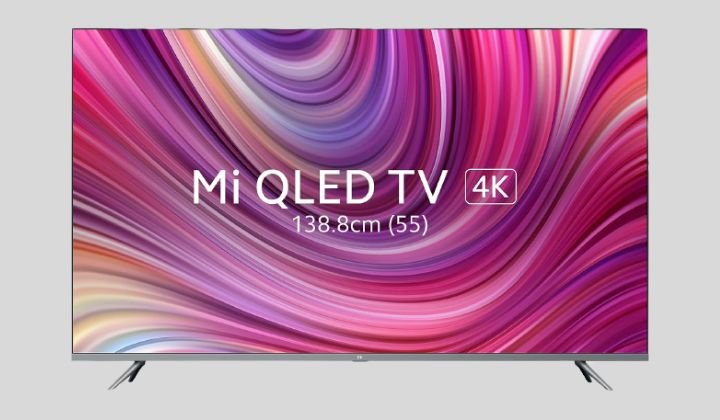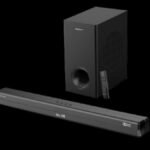Lots of queries have been pouring in regarding Mi QLED TV. People are curious to know whether Mi QLED TV is the best option in the budget segment. Today in this article, apart from telling you in detail about Mi QLED TV’s performance, I will also elaborate on how it is superior or inferior to Oneplus QLED TV.
First of all, I would like to clarify which TV to buy between budget 4k & budget QLED TV. So the answer to this depends on your requirements. People who prefer natural colours will find the colours of the QLED TV to be too saturated. QLED is for those who prefer vibrant & punchy colours.
However, at times, the colour reproduction of budget QLED TVs tends to appear unnatural, which might irritate some. Apart from this, if you generally watch content through a set-top box, you should avoid QLED TVs because a normal 4k or FHD TV is better suited to watching 720p & 1080p content.
The best performance of QLED TV is achieved while watching high-resolution, 4k video. Even Samsung’s QLED TVs, till last year, were ineffective in upscaling picture quality. QLED is an LCD TV having a 4k resolution too.
However, in QLEDs, the light coming through the LEDs is passed through a Quantum Dot layer, enhancing the colours and brightness. But, this doesn’t mean at all that a QLED TV will have better brightness than an ordinary 4k TV. It only means that the inherent brightness gets augmented in a QLED TV.
For example: If it is 250 Nits, after passing through Quantum Dots, it might get enhanced to 280 Nits.
Right now, Samsung QLED TVs give you the best QLED experience. Samsung QLED TVs have bright & punchy colours, which don’t look unrealistic at all. Very soon, Samsung is going to shut down LCD manufacturing units. It plans to manufacture QLED TVs that will have brighter panels than OLEDs despite displaying OLED-like picture quality.
Those QLED-OLED TVs will not even be marred by burn-in issues. Those TVs will feature Quantum dots with a self-emitting diode. Every dot will get the capacity to emit light itself without depending on any LED source. Those QLED TVs will also not be marred with any backlight bleeding problems & picture quality will be better than OLEDs.
Within a year or two, these TVs are expected to hit the market. But, as you know, Samsung QLED TVs are pretty costly, so we need to look for cheaper options in the budget category. In this article, I will tell you the strengths & weaknesses of both these TVs, apart from telling which TV excels on which account.
Comparison between Mi Q1 55-inch QLED and Oneplus Q1 55-inch QLED TV
Specifications:
| General Info | ||
|---|---|---|
| Brand | Xiaomi | OnePlus |
| Product Name | Mi Q1 | Q1 Series |
| Model | L55M6-EQG | 55Q1IN-1 |
| Display Size | 55 inch | 55 inch |
| Screen Type | QLED | QLED |
| Built-In Wi-Fi | Yes | Yes |
| Launch Year | 2020 | 2019 |
| Price | ₹54,999 | ₹62,899 |
| Connectivity Options | ||
|---|---|---|
| HDMI | 3 | 4 |
| USB | 2 | 2 |
| NFC Support | No | NO |
| RGB Cable | Yes | – |
| PC Audio In | – | Yes |
| PC D-sub | – | Yes |
| Headphone Jack | Yes | No |
| Video Features | ||
|---|---|---|
| Brightness | – | 350 nits |
| Contrast Ratio | – | 4000:1 (Static) |
| Picture in Picture | No | NO |
| Analog TV Reception | – | Yes |
| Digital TV Reception | – | Yes |
| Panel Type | DLED | QLED |
| View Angle | 178 degree | 178 degree |
| Refresh Rate | 60Hz | 60Hz |
| Aspect Ratio | 16:9 | 16:9 |
| Digital Noise Filter | – | Yes |
| Other Video Features | Dynamic Noise Reduction, Color Temperature Control, 5 Picture Mode | NTSC 120%, Dolby Vision, MEMC, De-Contour, Noise Reduction, Super Resolution, Dynamic Contrast |
| Smart Specs | ||
|---|---|---|
| Processor | MTK 64-bit Quad Core | MTK5670 |
| Number of Cores | 4 | 4 |
| Operating System | Android | Android |
| Graphic | Mali G52 MP2 | Gamma Color Magic Chip |
| RAM | 2 GB | 3 GB |
| Storage | 32 GB | 16 GB |
| Clock Speed | 1.5 GHz | – |
| Screen Mirroring | Yes | Yes |
| Netflix | Yes | Yes |
| Youtube | Yes | Yes |
| Disney+Hotstar | Yes | Yes |
| Prime Video | Yes | Yes |
| Bluetooth | Yes | Yes |
| Audio Features | ||
|---|---|---|
| Speaker Type | Box | Box |
| No. of Speakers | 6 | 6 |
| Surround Sound | Stereo Sound | Dolby Atmos |
| Sound Technology | Dolby Audio, DTS-HD | Dolby Digital Plus, DTS-HD |
| Speaker Output RMS | 30 W | 50 W |
| Supported Audio Formats | Dolby Audio, MP3, FLAC, AMR, DTS, ADPCM, AAC, OGG, WMA, WAV | AMR, AAC, AC/E-AC3, DTS, MP3, WAV, FLAC, AC4 |
| Sound Mode | Standard, News, Movie, Game, Custom | Standard, Surround, Clarity, User |
Build Quality:
Mi TV: The built quality of the Mi QLED TV is decent. From the front & sides, it imparts a premium feel. However, the carbon fibre finish on the rear fails to impress.
Oneplus: The overall built quality & looks of the Oneplus TV make it more premium than the Mi QLED TV.
Connectivity Options:
Mi TV comes with 3 HDMI ports with HDCP version 2.1, missing in the Oneplus TV. This version of HDMI makes Mi TV fully compatible with the PS5 gaming console.
This is the first TV in the budget category that gets HDMI 2.1. Connecting a 5.1 or 7.1 channel speaker system to the HDMI eARC of Mi TV will give you a better detailed audio output. Even the audio output through a Dolby Atmos soundbar would be better than Oneplus TV. On this point, Mi TV is a clear winner.
Backlighting:
Oneplus comes with ELED Backlighting, whereas, Mi TV has DLED backlighting.
Difference between DLED vs ELED:
Generally, in the budget segment, DLED or ELED hardly makes a difference. The difference depends on the quality & quantity of LEDs used in a TV. DLED backlighting effectively enhances the picture quality only if LEDs are fitted generously all over the back surface of the TV. Many companies flaunt DLED backlighting on their TVs even if only a few LEDs are fitted on the back surface, which is misguiding.
Also Check: Best 50-inch 4k TV under 40000 INR in India
Many higher-end TVs of Sony have ELED backlighting & their performance is far better than any DLED TV of the budget category. If an ELED TV has a good number of LEDs fitted on it, then it would outperform a DLED TV that has a lesser number of LEDs. This is why it would be unjustified to label a TV as inferior or superior based on its backlighting.
Brightness:
Oneplus has honestly mentioned its QLED TV’s peak brightness as 350 Nits; however, Xiaomi is silent on it. The actual brightness of the Mi TV is around 300 Nits. This difference is easily visible when you watch both these TVs side by side. On the brightness front, Oneplus is the clear winner.
Picture Quality:
The overall picture quality of the Oneplus QLED TV is better. As Oneplus has more brightness, minor details that go missing on Mi TV are more apparent on Oneplus TV.
Colour Reproduction:
The Color reproduction of Oneplus is also better than the Mi QLED TV. On Oneplus, you even get to see a wider colour gamut.
Generally, the colours in Mi QLED TVs look good, but they fail to reflect the vibrancy seen in Samsung QLED TVs. Sometimes, a pinkish or greenish tint tends to dominate Mi QLED TV’s colour reproduction, which affects this TV’s colour accuracy.
On the other hand, the colour reproduction of the Oneplus TV is more accurate than the Mi TV. The colour vibrancy that is generally seen while watching 4k content on Mi TV gets minimized while watching normal content.
Also Check: Best TV under 1 lakh INR in India
Black Levels:
Due to the VA panel, Mi TV displays a good contrast ratio and adequately deep blacks. But somewhere, blacks look grey. In Oneplus, the backlight bleeding does overpower the black level, making it not so deep. Right now, no backlight bleeding is seen on the Mi TV. This might be because it has a lower brightness than the Oneplus TV.
On, Oneplus TV, the LEDs have been aligned on the edges, whereas, on Mi TV, a lesser number of LEDs have been sparingly fitted on the back surface, so its backlight is not visible. However, Minor details are not so much visible on the Mi TV as on Oneplus, which has better detail clarity. Because of low brightness, the HDR 10 & Dolby Vision performance on Mi QLED TV is not something that can be elaborated upon enthusiastically. The HDR performance of Oneplus is a tad better than Mi TV.
Also Check: Best TV under 70000 in India
“Overall picture quality, Oneplus, due to higher brightness & better colour reproduction performs better. However, the not-so-deep blacks & backlight bleeding certainly give a valid reason for purchasing it”.
If you don’t watch both these TVs side by side, you will find the picture quality of Mi TV pretty decent.
Motion Blur:
Motion blur is pretty unavoidable during fast action scenes. Reality flow doesn’t seem to play any major role in stopping it. Instead, when the motion interpolation settings are switched on, the digital noise increases, marring the picture quality. And, Oneplus, too, the motion blur is pretty visible during fast action scenes.
Viewing Angles:
Considering that Mi TV has a VA panel, the viewing angles are pretty decent. Even when seen from a wider angle, colours don’t tend to distort much. In Oneplus, the viewing angles are not that good.
Audio Quality:
Oneplus TV fails to meet expectations according to its power output, whereas the 30W speaker system of Mi TV performs beyond expectations. However, don’t expect much from it as on full volume, the audio does get distorted.
However, assessing its overall sound performance, the audio of the Mi TV is loud & pretty decent, Significantly better than previous models of Xiaomi.
Also Check: Best TV under 50000 INR in India
In normal usage, you will not need any external soundbar with it. Oneplus fails to display any noteworthy Dolby Atmos effect, so Dolby Atmos’ absence on Mi TV is not a major disappointment. Though HDMI eARC of Mi TV, you can get a good sound output when connected to a Dolby Atmos soundbar.
Smart Specifications:
Both Oneplus QLED & Mi QLED TVs come with Android OS; however, Mi TV runs on the latest Android 10 operating system, whereas, Oneplus continues running on the old Android OS.
Though there is not much of a difference, the latest OS certainly comes as an added attraction. Oneplus has 3GB RAM & 16GB storage, whereas, Mi TV comes with 2GB RAM & 32GB storage.
Though high RAM is more important than storage, the 2GB RAM of the Mi TV does not disappoint. It seems pretty sufficient to run all applications smoothly. The UI of Mi TV is smoother & more responsive than Oneplus TV.
Also Check: Best TV under 80000 in India
For casual gaming, the Mi TVs RAm does a sufficiently good job, but for high-end gaming, you will certainly require a gaming console. Still, you will not be able to play 120Hz games as their refresh rate is limited to 60Hz.
Mi QLED TV and Oneplus QLED TV UI
The Mi TV comes with the latest version of Patchwall, which makes it even more interesting. The Patchwall UI keeps all contents of your tastefully organized, making it easier to use this TV. The Patchwall UI of Mi Tv is superior to the Oxygen UI of Oneplus.
Which QLED TV should you buy?
In this article, I have acquainted you with the shortcomings and the virtues of these TVs; I have told you everything openly, and now you have to decide. When it comes to Mi QLED TV, it is not that Xiaomi has brought forward some revolutionary products in the QLED budget category, nor its pricing is that competitive. If its price were around Rs 45,000, it would have been a sought-after QLED TV in the affordable range. So now, you need to decide whether you want a QLED TV for its vivid 4k content or a normal 4k TV that gives you a round good performance.
If you don’t expect a high-range QLED TV-like performance from Mi QLED TV, even at rs 55,000, it is a pretty decent TV that gives you a satisfactory performance. Oneplus is 7-8 thousand costlier, and its picture quality is a tad better, but it has its glaring disadvantages. So there is no logic in investing those extra bucks in it. Those who are enthusiastic about purchasing their first QLED TV, which gives them punchy colours, are good options.
FAQs: Mi QLED and Oneplus QLED TV
Are MI 55 TVs good?
Yes, the Mi TV is good, it comes with the latest Android 10 version, it is a pretty decent TV that gives you a satisfactory performance under 55,000 INR.
Is Qled better than OLED?
I think Both are better in their place: QLED TVs are essentially LED TVs but with a quantum-dot filter between the LED backlight and LCD layer, which helps enhance brightness. and the other hand, OLED TVs, short of the contrast levels and deep blacks that OLED TVs offer
Which TV is better MI or OnePlus?
If you don’t expect a high-range QLED TV-like performance from Mi QLED TV, even at rs 55,000, it is a pretty decent TV that gives you a satisfactory performance. Oneplus is 7-8 thousand costlier, and its picture quality is a tad better, but it has its glaring disadvantages.
What is the processor integrated into the Mi QLED Smart TV 55-inch?
Mi QLED Smart TV comes with a MediaTek MTK 64-bit Quad-Core processor.
What is the best feature of the newly launched Mi QLED 4K 55-inch Smart TV?
These are some best features of mi QLED TV: High-quality PatchWall, Android10, HDR 10+, and DTS-HD Audio.







Hey Prince,
Thanks for this wonderful, honest and detailed review. One of the best reviews I have seen. My confusions are clear on opting MI or One Plus QLED TV after reading your article. Keep up ur good work.